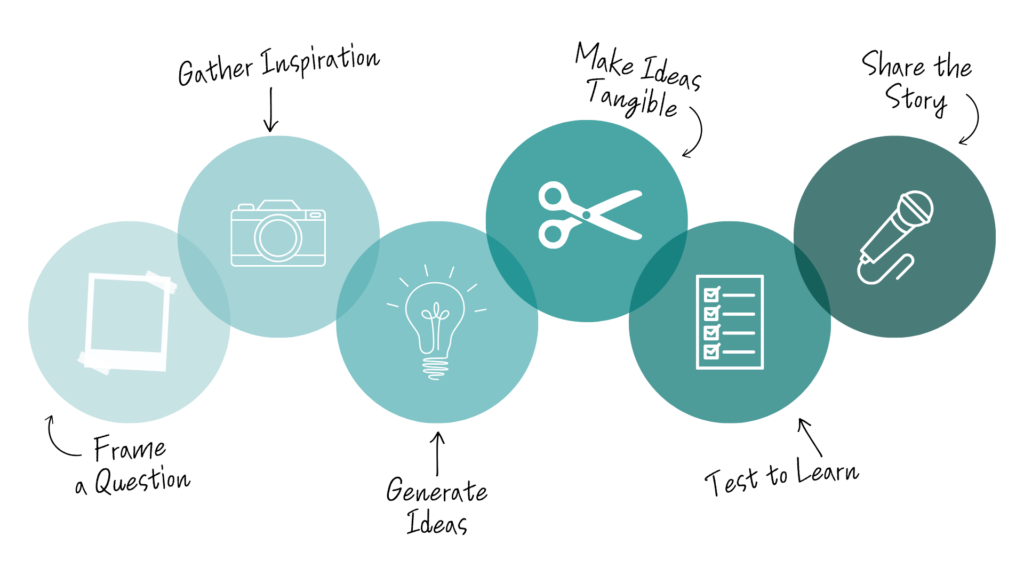Design thinking is a tool for problem solvers of all kinds to incorporate creative solutions-oriented strategies to address complex issues. Not only reserved for “designers” of fashion, products or graphics, it is a useful tool for strategic planning of all kinds. Major companies, like Pepsi, Airbnb, and Microsoft, are known for using it to design their products and services.
It can also be useful for business sustainability planning and strategy development. Indeed, sustainability issues such as climate change or resource conservation present complex, long-term problems affecting multiple groups of people both inside and outside an organization. Sometimes solving one sustainability issue can result in trade-offs or synergies with another sustainability issue.
Design thinking enables sustainability leaders to focus on innovation and iterative ways of working towards solutions, allowing a wider range of solution pathways to emerge. Design thinking also places strong emphasis on understanding customer or other relevant parties’ needs, to ensure solutions address issues using empathy to understand different viewpoints and examining the broader contexts in which solutions come to life.
Design Thinking Definition
Design thinking is a human-centered way of generating ideas to address future needs through solution-focused thinking. According to IDEO, this includes considerations related to desirability for user groups, feasibility within economic, technological or other constraints and viability of successful adoption within a business model.
What are the Main Steps within Design Thinking?
While we are used to applying processes in a sequence from start to finish, design thinking is more of an iterative process. Its different stages can be woven into the problem-solving cycle multiple times, and they don’t need to occur in order.

According to IDEO, these stages include:
- Frame a question: Determining the right question to ask and understanding the relevant context surrounding this question.
- Gather inspiration: Investigate people’s behaviors and needs to inspire new ways of thinking about the problem.
- Generate ideas: Brainstorm a wide range of possible ways to meet people’s needs, allowing for innovative or unconventional ideas to come forward.
- Make ideas tangible: Develop rough prototypes of the ideas quickly.
- Test to learn: Get feedback on the ideas and refine the prototypes. Remove the “bad” ideas that don’t satisfy the desirability, feasibility, and viability requirements.
- Share the story: Keep track of the learnings along the way and share these insights with others.
With its human-centered focus, design thinking can help avoid issues like “band-aid solutions,” which are short-lived and fail to gain lasting support. It may also lead to simplistic solutions based on buzzwords or outdated ideas that don’t align with people’s contemporary views or lived experiences.
How is Design Thinking different from Product Design?
Product design is an evolving field that spans both older and newer ways of looking at product development. Traditionally, product design tended to focus on meeting a specific set of pre-defined constraints defined by a given design problem. Design thinking changed this process to allow the premise of the problem itself to evolve as more testing and information is gathered.
Design thinking grew in popularity in parallel to user experience (UX) design, which benefits from design thinking. Dan Norman, who popularized UX, combined aspects of branding, design, usability and function as considerations within product design. Beyond looking at how well products perform a function, user experience centers attention on enabling enjoyable product use by empathizing with users.
Another key difference is that design thinking is not limited to product design. It can apply to problem solving of all kinds.
Why is Design Thinking Useful for Sustainability?
Sustainability issues are interconnected problems that require organizations to transition and embrace change. In this sense, design thinking can be useful for a wide variety of sustainability issues related to:
- Sustainability strategy
- Stakeholder engagement
- Developing sustainable products
- Sustainability reporting
Sustainability Strategy and Design Thinking
With its emphasis on finding long-term solutions, design thinking is particularly relevant for identifying lasting solutions amidst changing circumstances. Achieving sustainable outcomes requires organizations to make ongoing progress over long periods of time in a continual cycle of improvement and changing external expectations from customers, investors, and regulators.
In design thinking, the “making ideas tangible” stage allows companies to start somewhere with a prototype to test and make improvements. While design thinking usually centers on a prototype as the main unit for testing and improvement, sustainability strategies usually focus on defining and working towards goals or targets.
Organizations can then apply the design thinking concept of iterative testing when defining strategies to reach the goal. Just as there is no one “right way” to design a prototype, there is no one path to progress toward a sustainability goal from an organizational change management perspective.
In our 2023 EarthLight Report, we proudly announced our newly approved near and long-term science-based greenhouse gas (GHG) emissions reduction targets with the Science-based Targets initiative (SBTi) for our Scope 1, 2, and 3 emissions. Working towards our ambitious and achievable 2040 net-zero emissions target will require creative, lasting solutions, which are a hallmark of design thinking.
Stakeholder Engagement and Design Thinking
Design thinking is a human-centered process of understanding a problem, which can help organizations get buy-in from multiple stakeholder groups. Sustainability outcomes are usually considered from the perspectives of multiple stakeholders. These can include internal stakeholders such as employees and customers. They can also include external stakeholders such as investors, community members, government, NGOs, and other groups that care about sustainability issues.
Our EarthLight Report shares the importance of stakeholder engagement to our own sustainability approach: “Feedback from our associates, customers, channel partners, suppliers, investors, and Board of Directors helps inform our thinking and approach to sustainability.”
When engaging stakeholders, sustainability teams and leaders need to identify relevant framing that motivates beyond the “compliance” or box-checking mindset of implementing a sustainability program. In the gathering inspiration stage, design thinking approaches consider the behaviors and needs of different groups of people. This way, a sustainability approach won’t alienate certain groups of stakeholders.
Stakeholder engagement is also a necessary part of change management as organizations undergo sustainability-linked transitions. This may require professionals from various backgrounds and experiences to participate in a process of ongoing improvement that requires them to learn, grow and evolve. Design thinking can help sustainability professionals to “frame a question” in a way that mentally prepares their colleagues and stakeholders for a long-term process of improvement.

Developing Sustainable Products and Design Thinking
Sustainable product design can touch on more than a product’s primary function, and design thinking can help identify these sustainability-linked impacts. Sustainable design may consider all of the environmental and social implications of products as well across their product life cycle. Design thinking can help to incorporate a broader range of ways to think through a product’s impacts and enable considerations like circularity, user experience, long-term viability and feasibility in future contexts come to the fore.
Our Earthlight report shares how we have leveraged emerging organizational needs to make sustainability impacts: “We develop and sell products and services that help our customers save energy, save operating costs, and reduce carbon emissions during usage. While building an even more valuable business, we are also reducing our carbon footprint and helping our customers do the same.”
Sustainability Reporting and Design Thinking
The “share the story” stage is, of course, relevant to reporting outcomes periodically in an annual sustainability report. Transparently communicating an organization’s story of sustainable transformation is key to sustainability reporting.
This includes adding perspectives gained through research and stakeholder engagement, as well as the iterative development of sustainability-linked programs, initiatives, policies, and procedures aligned with an organization’s business strategy. Sharing sustainability improvements through reporting narratives across time through both data visualizations and qualitative contextual details explaining the why can generate broader interest in your organization’s actions. It can also motivate other organizations and reinforce the importance of sustainability within your industry.
Read more about how we are leveraging sustainability across our products, operations and communications in our 2023 EarthLight Report.



